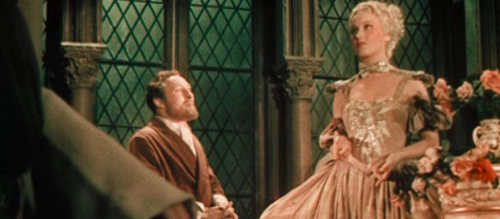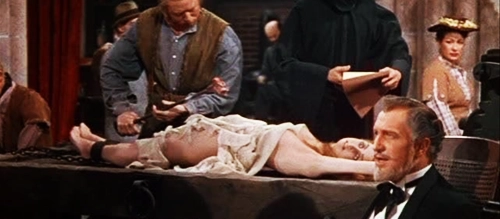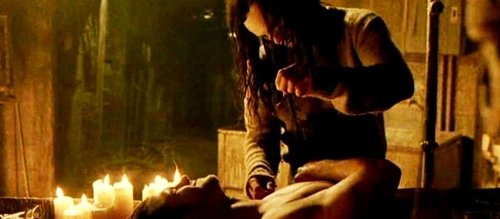Original vs Remakes: Mystery of the Wax Museum vs House of Wax
Horror remakes – what are they good for? Well, while they are often blatant cash-ins, if they are given enough distance from the original films they are occasionally at the very least interesting new takes on popular stories. A word of warning: if you already find tourist attractions like Madame Tussauds creepy, this particular comparison piece may not be the one for you…
Many horror fans are aware of two versions of House of Wax, the macabre Vincent Price film from the early 1950s and the far more questionable one with Paris Hilton from 2005, but some might not be aware that the former was already a remake.

A film from the endlessly versatile Michael Curtiz (who directed the similar horror Doctor X the year before, and most famously Casablanca), Mystery of the Wax Museum was released in 1933 and is most interesting as a record of the short-lived two-strip Technicolor process, now just a curious artefact of film history. Yet its basic plot – a brilliant artist running a failing wax museum who is horribly disfigured and driven mad in a fire set by his business partner – is what is largely replicated in House of Wax (1953). The second remake uses the wax museum setting for its final act but little else, telling a very different type of horror story.
Pre-Code movies (the self-censoring Motion Picture Production Code, A.K.A Hayes Code, that was brought in from 1934) had the potential to be much more gruesome and provocative than those released only a couple of years later, so it may take some by surprise how far a 1933 film is able to go in terms its imagery and themes. In addition to Lionel Atwill’s sculptor Ivan Igor (great horror name) being turned into a scarred killer, the plot also heavily incorporates grave robbery, post-mortem mutilation and substance abuse.

Mystery of the Wax Museum was re-titled and remade for the first time as House of Wax two decades later, partly in order to capitalise on the latest hot filmmaking trend: 3-D. By the early 1950s, Vincent Price became the most recognisable American horror movie star on the back of this, which serves as a great vehicle for his unique theatrical grandstanding talents. The film, the first colour 3D release from one of the big studios, was directed by Andre DeToth, a longtime (and often uncredited) Hollywood screenwriter and second unit director who ironically could not see 3D himself due to visual impairment.
Both of the first two films hit more-or-less the same story beats with Igor (renamed as Jarrod in the 1953 film) being the under-appreciated Michelangelo of wax sculpture, dedicating everything to his wondrous recreations of iconic and important historical figures, and refusing to create more carnivalesque fare like depicting serial killers and scenes of grisly violence to bring in the punters. The earlier film has the sculptor fixated on his masterwork statue of Marie Antoinette and the latter is dedicated to his Joan of Arc, but both versions of the character find and become obsessed with women who appear to be uncanny real-life representations of their idols; women they want entomb in wax as the centrepieces of their latest art installations which are secretly made up of wax-covered corpses snatched from the morgue.
House of Wax transposed the original contemporary 1930s story to an early 1900s setting to give the filmmakers an opportunity to incorporate misty, gas-lit night-time scenes, and to give the whole affair a more old-fashioned, atmospheric Gothic vibe. It’s a pretty effective horror mystery that nonetheless leans on some outdated tropes, like disfigurement causing madness and someone deviously “putting on” a disability to avert suspicion. Like Mystery of the Wax Museum, the most memorable horror scene towards the end of the film involves our damsel in distress shattering the apparently flesh-and-blood face of her tormentor to reveal the hideously scarred visage hidden beneath.
Changing the setting and some incidental details aside, like giving Jarrod a hulking, silent assistant called Igor after the original mad wax artist, House of Wax is very much a re-tread of the earlier film with better production values and effects. Despite a mixed critical reception and a somewhat old-fashioned horror movie plot, it became a massive hit for Warner Brothers, dominating the box office for weeks and enrapturing audiences with its sensationalism and technological gimmickry.

The second reinterpretation didn’t come for another 52 years and was also very much a product of its time. Like many horror remakes of the early to mid-2000s (Texas Chainsaw Massacre, Halloween, The Hills Have Eyes), the film seems determined to explain away every last ambiguity, solve every mystery and present as much graphic violence as it can get away with.
The 2005 film is essentially… what if House of Wax was also Texas Chainsaw Massacre?
We see a group of teenagers on a road trip that takes them through an isolated former industrial town. There they discover Bo and his brother Vincent (both played by Brian Van Holt), formally conjoined twins who are the only two living residents and have preserved their family and neighbours in eerie wax snapshots of small town life. The wax artist in this version is disfigured by an accident of birth, is completely silent, and wears a pristine mask as he takes his victims to add to his ongoing grisly art project.
Most of the film is a pretty run-of-the-mill slasher with disposable and interchangeable young people being picked off by a crazed killer in increasingly more elaborately brutal ways. Director Jaume Collet-Serra (The Shallows, Jungle Cruise) decides to realistically depict what boiling hot wax hitting your skin then later being peeled off would look like, and some of the bodily mutilation in the movie seems particularly unnecessarily cruel. His film is the least worth your time out of the three but is notable for having the best final act in a House of Wax film, which sees our final two survivors running from Vincent through his vast wax museum that is entirely constructed from the substance and has been set ablaze, melting away spectacularly around them. It’s an almost entirely practical sequence achieved with, among other things, a lot of peanut butter.
This remake, like the majority of similar attempts to relaunch horror franchises around this time, did not go down well. Paris Hilton’s casting was so negatively received at the time by horror fans that the Warner Bros marketing team decided, rather distastefully, to promote the movie as the place to “See Paris Die”. Roger Ebert, damning with faint praise in his review, said the film “will deliver most of what anyone attending House of Wax could reasonably expect… assuming it would be unreasonable to expect very much”. The 2005 film was not the financial success the previous iteration was, though it did spawn a modest cult following of gore hounds.
There’s clearly enough in this story to make multiple remakes seem worthwhile. The ghoulish premise, creepy atmosphere, and memorable prosthetics and effects work in each House of Wax makes them all a certain draw for horror fans, and which one you prefer will depend largely on your taste in scary movies. If you don’t mind hammy acting, then the first two films are probably better-made and are surprisingly technically sophisticated for mid-budget films made 90 and 70 years ago. The modern version offers fairly memorable gore and pleasingly doesn’t resort to CG-shortcuts very often, but it also has the most basic characterisation and is the most insistent on unnecessary exposition of the three films. Give one, or all of them a go; you’ll never look at an uncanny wax model of a celebrity in quite the same way again.

